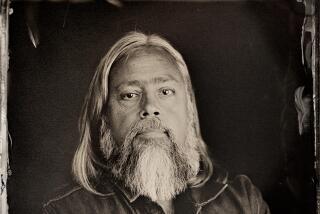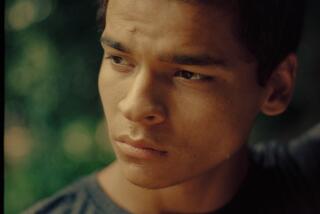Facts of the ‘Mohicans’ : A Historian Is Impressed by the Details in the Movie but Sees Inaccuracies in the Depiction of Frontier Life
- Share via
As director Michael Mann’s movie version of “The Last of the Mohicans” proves, the quest for authenticity when re-creating American frontier life has become nearly as important as the story.
Hollywood no longer makes Indian characters utter such hokum as “me smokee peace pipe.” American Indians are now cast in Indian roles, and the white man is not necessarily the good guy.
But how does Mann’s re-creation of a chapter of the French and Indian War (1754-1763) in this latest adaptation of James Fenimore Cooper’s classic novel play as history?
For UCLA American history Prof. Joyce Appleby, the movie’s focus upon the love affair between the frontier scout Hawkeye (Daniel Day-Lewis) and his ladylove Cora (Madeleine Stowe), set against the backdrop of the British surrender of Fort William Henry to the French, is “an excellent way to interest people in history.”
Appleby, whose most popular class at UCLA is the survey course “Pre-Revolutionary America to the Civil War,” went to the film earlier this week at the request of The Times, but she had already recommended that her students see it.
“I’m thrilled if they’re interested in learning more and I take a great deal of pleasure in demonstrating how it’s inaccurate. When you explain its inaccuracies, you teach something.”
Appleby, a published authority on 17th- and 18th-Century British and American history and past president of the Assn. of American Historians, lauds director Mann’s attention to detail: the costumes, sets and use of the French and Indian languages. Production notes distributed by 20th Century Fox, the studio that made the movie, list numerous experts hired for the project--from an 18th-Century frontier consultant to Delaware language instructors.
She said the overall look of the picture “certainly creates the sense of the trackless wilderness” that then existed in the lush wilderness of the upper Ohio River Valley, where the novel was set. (The movie was shot in North Carolina, where virgin forests resembling those once found in the Fort William Henry area of upper New York state still exist.)
“Cooper said (in his novel) that the English and French had to find each other to fight each other--and that’s portrayed very well.”
However, some of the dialogue spoken by the Colonial militia advocating individual rights to their commanding British officers was premature to the Colonial independence movement that would come later.
One of Appleby’s criticisms of Mann’s picture is odd given the director’s reputation for the visceral treatment of subjects. A critical scene in which Col. Duncan Munro (Maurice Roeves) and his British troops are attacked by Indians led by the vengeful Huron Magua (Wes Studi) in an open field after they surrender Fort William Henry to the victorious Marquis de Montcalm (Patrice Chereau) is “much less grisly” than in the actual 1757 event, she said.
The Hurons, who had allied themselves with the French to trade furs for guns and other goods, overtook the British inside Fort William Henry despite Montcalm’s assurances to Munro his troops would be safe. Appleby said the Indians went after scalps first inside the fort’s surgery ward--where soldiers were most vulnerable--killing women and children later. An estimated 250 died, another thousand fled.
Appleby doesn’t take exception to Mann’s dramatic reworking, but she said the movie leaves unanswered the reaction of Montcalm when he realizes that the Hurons have disobeyed him.
“It would be a terrible disgrace for Montcalm,” she said. “He guarantees safe passage to the English and the Indians fall on them.”
What she finds to be most inconsistent with the time and place is how Mann (and co-screenplay adapter Christopher Crowe) have modernized the behavior of the key characters, finding most flaw with the central relationship between Hawkeye and Cora Munro.
“The movie was so fixed on the romance,” she said. “It would be hard for us to believe (a colonel’s daughter) could actually be inhibited from appreciating someone as handsome as Daniel Day-Lewis, but it’s highly improbable (that she would have been attracted to him). Then, there was a much stronger sense of social differences. He would just have been a lower-class person to her.”
When movie audiences first see actress Stowe, she embraces her British suitor Heyward (Steven Waddington) when he comes to ask her hand in marriage. This too, Appleby said, would be out of line with the more formal conventions of the day.
Cooper, she said, was much more true to his times. There is no romance between Hawkeye and Cora in the novel. Cora, a mulatto, is passed over by Heyward, who favors her younger sister Alice (played in the movie by Jodhi May). It is Magua who is in love with Cora and is thwarted in his desire to marry her.
Appleby said she was impressed by the “physicality” of Day-Lewis and those who portray the so-called “last” Mohicans who adopt him: Russell Means as his father Chingachgook and Eric Schweig as his brother Uncas, who are constantly seen running through the woods (or “courier du bois, “ as the French called them then), up rocky hillsides brandishing rifles--even surviving a death-defying waterfall jump.
The historian finds fault with the tone of the movie’s final bloody encounter between the Mohicans and Hurons over Uncas’ vain attempt to rescue Alice from Magua.
“There is something slightly facile about this slaughter followed by all this great spoken reverence at the end about the spirits taking up loved ones.” She attributes this to a revisionist interpretation of American Indians that places them in a sympathetic light, as a spiritual people in sync with nature and the Earth’s ecology. “(Mann) seems to want it both ways,” she said.
And despite the title (again, a dramatic invention of Cooper), Appleby points out that Mohican descendants survive to this day.
But she is quick to say that she doesn’t like “purism” in entertainment. “It doesn’t bother me when students see this kind of (period) drama if it’s compelling and isn’t perfect. You go back into the context and explain why this couldn’t have been the case given what we know of the events, the institutions, the ideas and the manners of the time.”
Her final analysis is that the movie, like the feature “Glory” and the television series “The Adams Chronicles,” two of her personal favorites, is certainly closer to “achieving verisimilitude” with American Colonial history than any of the previous Hollywood generation.
More to Read
Only good movies
Get the Indie Focus newsletter, Mark Olsen's weekly guide to the world of cinema.
You may occasionally receive promotional content from the Los Angeles Times.










